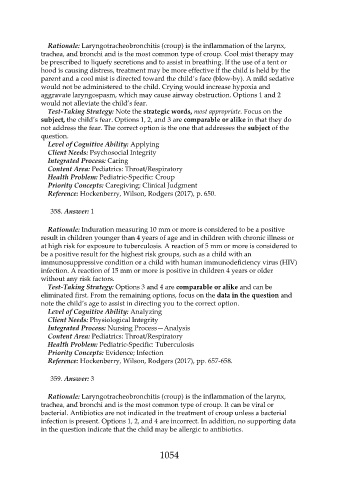Page 1054 - Saunders Comprehensive Review For NCLEX-RN
P. 1054
Rationale: Laryngotracheobronchitis (croup) is the inflammation of the larynx,
trachea, and bronchi and is the most common type of croup. Cool mist therapy may
be prescribed to liquefy secretions and to assist in breathing. If the use of a tent or
hood is causing distress, treatment may be more effective if the child is held by the
parent and a cool mist is directed toward the child’s face (blow-by). A mild sedative
would not be administered to the child. Crying would increase hypoxia and
aggravate laryngospasm, which may cause airway obstruction. Options 1 and 2
would not alleviate the child’s fear.
Test-Taking Strategy: Note the strategic words, most appropriate. Focus on the
subject, the child’s fear. Options 1, 2, and 3 are comparable or alike in that they do
not address the fear. The correct option is the one that addresses the subject of the
question.
Level of Cognitive Ability: Applying
Client Needs: Psychosocial Integrity
Integrated Process: Caring
Content Area: Pediatrics: Throat/Respiratory
Health Problem: Pediatric-Specific: Croup
Priority Concepts: Caregiving; Clinical Judgment
Reference: Hockenberry, Wilson, Rodgers (2017), p. 650.
358. Answer: 1
Rationale: Induration measuring 10 mm or more is considered to be a positive
result in children younger than 4 years of age and in children with chronic illness or
at high risk for exposure to tuberculosis. A reaction of 5 mm or more is considered to
be a positive result for the highest risk groups, such as a child with an
immunosuppressive condition or a child with human immunodeficiency virus (HIV)
infection. A reaction of 15 mm or more is positive in children 4 years or older
without any risk factors.
Test-Taking Strategy: Options 3 and 4 are comparable or alike and can be
eliminated first. From the remaining options, focus on the data in the question and
note the child’s age to assist in directing you to the correct option.
Level of Cognitive Ability: Analyzing
Client Needs: Physiological Integrity
Integrated Process: Nursing Process—Analysis
Content Area: Pediatrics: Throat/Respiratory
Health Problem: Pediatric-Specific: Tuberculosis
Priority Concepts: Evidence; Infection
Reference: Hockenberry, Wilson, Rodgers (2017), pp. 657-658.
359. Answer: 3
Rationale: Laryngotracheobronchitis (croup) is the inflammation of the larynx,
trachea, and bronchi and is the most common type of croup. It can be viral or
bacterial. Antibiotics are not indicated in the treatment of croup unless a bacterial
infection is present. Options 1, 2, and 4 are incorrect. In addition, no supporting data
in the question indicate that the child may be allergic to antibiotics.
1054

